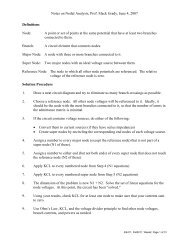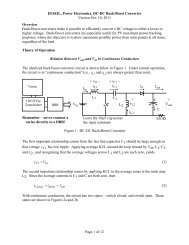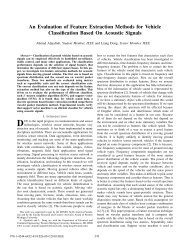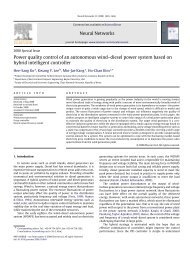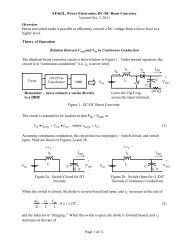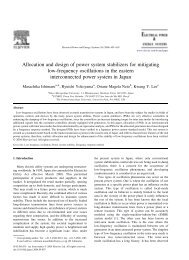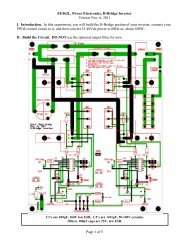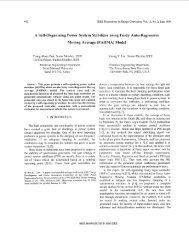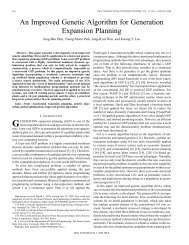1304 J.M. Davis et al. / J. Math. Anal. Appl. 332 (2007) 1291–13073. <str<strong>on</strong>g>The</str<strong>on</strong>g> Dirac delta functi<strong>on</strong>alLet f,g : T → R be given functi<strong>on</strong>s with f(x)having unit area. To define the delta functi<strong>on</strong>al,we c<strong>on</strong>struct the following functi<strong>on</strong>al. Let Cc ∞(T) denote the C∞ (T) functi<strong>on</strong>s with compactsupport. For g σ ∈ Cc ∞(T) and for all ɛ>0, define the functi<strong>on</strong>al F : C∞ c (T, R) × T → R byF ( g σ ,a ) { ∫ ∞0δa H =(x)gρ (σ (x)) x, if a is right scattered,∫ ∞ 1lim ɛ→0 0 ɛf ( )xɛg(σ(x))x, if a is right dense.<str<strong>on</strong>g>The</str<strong>on</strong>g> <strong>time</strong> scale Dirac delta functi<strong>on</strong>al is then given by〈δa (x), g σ 〉 = F ( g σ ,a ) .We need to see how the delta functi<strong>on</strong>al acts <strong>on</strong> functi<strong>on</strong>s from Cc ∞ (T). For this purpose, letg : T → R be given such that g σ ∈ Cc ∞ (T). Ifa is right dense, c<strong>on</strong>sider{ 1ɛ, if a x a + ɛ,f(x)=0, else,with the understanding that any sequence of ɛ’s we choose will be under the restricti<strong>on</strong> thata + ɛ ∈ T for each ɛ in the sequence. <str<strong>on</strong>g>The</str<strong>on</strong>g>n for h(x) = g σ (x), we have (for any antiderivativeH(x) of h(x)),F ( g σ ,a ) ∫= lim f(x)h(x)xɛ→0∞If a is right scattered, thenF ( g σ ,a ) =0∫ a+ɛah(x) x= limɛ→0 ɛH(a+ ɛ) − H(a)= limɛ→0 ɛ= H (a) = h(a) = g ( σ(a) ) = g(a).∫ ∞0δ H a (x)gρ( σ(x) ) x = g ρ( σ(a) ) = g(a).Thus, in functi<strong>on</strong>al terms, the Dirac delta functi<strong>on</strong>al acts as〈g σ ,δ a〉= g(a),independently of the <strong>time</strong> scale involved. Also, if g(t) = e ⊖z (t, 0), then 〈δ a ,g σ 〉=e ⊖z (a, 0), sothat for a = 0, the Dirac delta functi<strong>on</strong>al δ 0 (t) has <str<strong>on</strong>g>Laplace</str<strong>on</strong>g> <str<strong>on</strong>g>transform</str<strong>on</strong>g> of 1, thereby producingan identity element for the c<strong>on</strong>voluti<strong>on</strong>. However, the present definiti<strong>on</strong> of the delay operator<strong>on</strong>ly holds for functi<strong>on</strong>s. It is necessary to extend this definiti<strong>on</strong> for the Dirac delta functi<strong>on</strong>al.To maintain c<strong>on</strong>sistency with the delta functi<strong>on</strong>’s acti<strong>on</strong> <strong>on</strong> g(t) = e⊖z σ (t, 0), it follows that forany t ∈ T, theshift of δ a (τ) is given by δ a (t, σ (τ)) := δ t (σ (τ)). With this definiti<strong>on</strong>, our claimholds:
J.M. Davis et al. / J. Math. Anal. Appl. 332 (2007) 1291–1307 1305(δ 0 ∗ g)(t 0 ) =∫ t 00= g(t 0 , 0)= g(t 0 )==∫ t 00∫ t 00δ 0 (τ)g ( t,σ(τ) ) τg(τ)δ t0(σ(τ))τg(τ)δ 0(t0 ,σ(τ) ) τ= (g ∗ δ 0 )(t 0 ).In other words, when we perform the c<strong>on</strong>voluti<strong>on</strong> 〈g,δ σ 〉, we must give meaning to this symboland do so by defining δ σ (t) to be the Hilger delta when t is right scattered and the Diracdelta if t is right dense. While this ad hoc approach does not address c<strong>on</strong>voluti<strong>on</strong> with an arbitrary(shifted) distributi<strong>on</strong> <strong>on</strong> the right, this will suffice (at least for now) since our eye is <strong>on</strong>solving generalizati<strong>on</strong>s of can<strong>on</strong>ical partial dynamic equati<strong>on</strong>s which will involve the Dirac deltadistributi<strong>on</strong>.We now turn to uniqueness of the inverse of the Dirac delta. We would like an analogue ofthe diagram given in the proof of <str<strong>on</strong>g>The</str<strong>on</strong>g>orem 1.4 where we move from the space of c<strong>on</strong>tinuousfuncti<strong>on</strong>s to its dual space (or at least restricted to the dual space of those functi<strong>on</strong>s that areinfinitely differentiable with compact support). As frequently happens when we move from aspace to its dual space, the diagram also becomes the dual of the original <strong>on</strong>e. Indeed, the diagramin terms of the dual space is shown in Fig. 4.<str<strong>on</strong>g>The</str<strong>on</strong>g> mappings γ and γ −1 in the dual diagram act <strong>on</strong> the <str<strong>on</strong>g>transform</str<strong>on</strong>g> spaces just as in Fig. 3.It is worth comparing Figs. 3 and 4 since X ⊂ X ∗ . So how do we rec<strong>on</strong>cile the two diagrams?We first must clarify what is meant by the identity map between the two dual spaces. <str<strong>on</strong>g>The</str<strong>on</strong>g> Diracdelta is defined in terms of its acti<strong>on</strong> <strong>on</strong> any functi<strong>on</strong>: in both dual spaces, 〈δ a ,g σ 〉=g(a).To make this agree with the map for the functi<strong>on</strong> spaces, note that for f ∈ C prd-e2 (T, R) andg ∈ C p-eo (R, R), the acti<strong>on</strong> of f(t) <strong>on</strong> h σ (t) = e⊖z σ (t, 0) should be the same as the acti<strong>on</strong> ofg(t) <strong>on</strong> ˜h(t) = e −zt . For example, the functi<strong>on</strong> <strong>on</strong> T that acts <strong>on</strong> h σ 1(t) with a result ofz 2 +1 isthe functi<strong>on</strong> f(t)= sin 1 (t, 0), while the functi<strong>on</strong> <strong>on</strong> R that acts <strong>on</strong> ˜h(t) with the same result isg(t) = sin(t). As another example, the functi<strong>on</strong> <strong>on</strong> T that acts <strong>on</strong> h σ (t) with a result of h(τ)zisthe <strong>time</strong> scale unit step functi<strong>on</strong>, while <strong>on</strong> R, the functi<strong>on</strong> that results in ˜h(τ)zis the c<strong>on</strong>tinuousstep functi<strong>on</strong>. Thus, in terms of the dual spaces, the map <strong>on</strong> the left hand side of the diagram is(C ∞ c (R, R))∗ L R (C ∞ cL −1RT f (R)γ −1I I γ L T (T, R))∗ T f (T)L −1T= I ◦ L−1 R ◦ γ −1Fig. 4. Commutative diagram in the dual spaces.






